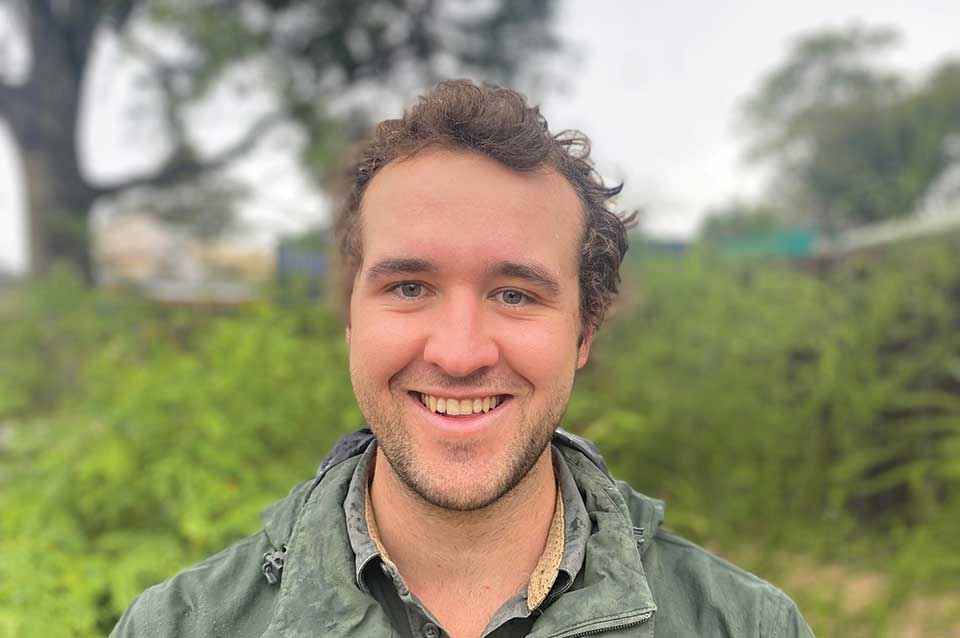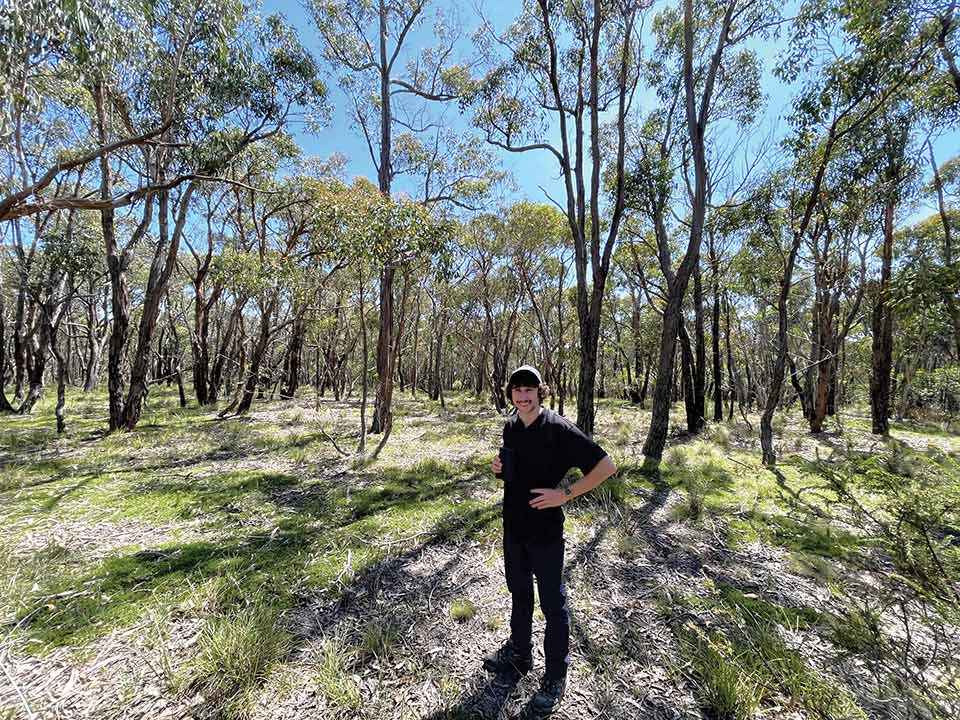Victorian Landcare Magazine - Winter 2024, Issue 87

Growing up surrounded by some of Victoria’s most significant and beautiful national parks, it’s no surprise that Bryce Watts-Parker pursued a career dedicated to the environment.
The Mallacoota local, who now works as a monitoring and project coordinator for East Gippsland CMA, spent many a weekend bushwalking, hiking, boating, exploring and snorkelling, and idolised David Attenborough and the late Steve Irwin.
“That fuelled my passion and interest for the local environment. I was one of those lucky few who knew where I wanted to go after Year 12 and continued on with my studies and then managed to land myself the work that I am in currently,” he said.
The first in his immediate family to attend university, Bryce studied a Bachelor of Biological Sciences at La Trobe University.
He was at home for the holidays when bushfires tore through the region in December 2019 and battled unsuccessfully alongside his father, Matt, to save the family home. More than 120 houses in Mallacoota and surrounding areas were destroyed in the fires and over one million hectares – an estimated 83 per cent of the land area – was burnt, devastating the people, wildlife and bushland.
Despite their own losses, Bryce stepped up to volunteer alongside another 11 community members leading the recovery locally. The youngest member of the Mallacoota and District Recovery Association, he acted as the dedicated media contact, and was the go-to person for all environmental questions and projects.
“Personally, and for my family, one of the best ways to process what happened and get back up on our feet was to contribute and help out within the local community,” he said.
That involved searching the blackened bush for injured wildlife, caring for them at the Mallacoota wildlife shelter, and distributing food and water for surviving animals.
Other post-fire activities included surveys and seed collection of the many local flora species, assisting Royal Botanic Gardens and Arthur Rylah Institute (ARI) scientists undertake post-fire surveys, and developing the Friends of Mallacoota community nursery, so people could re-establish their fire-ravaged gardens using local species.
Between COVID-19 lockdowns, Bryce coordinated local replanting days and working bees to help both the bush and the people recover, and distributed more than 200 nest boxes to provide shelter for displaced animals. A paint your nest box competition was hugely successful in engaging members of the community.

Above: One of the projects Bryce Watts-Parker is most proud of is the Mallacoota Endemic Garden, which has specimens of more than 50 rare, threatened or endangered species, including the critically endangered Mt Imlay Mallee (Eucalyptus imlayensis), which was completely burnt out in the Black Summer bushfires.
“Helping people replant their immediate backyards, the surrounding bushland and private property, has also been a wonderful contributor socially. It’s brought people together and provided a common goal to allow people to heal through that time,” he said.
One of the projects he’s most proud of is the Mallacoota Endemic Garden – Victoria’s smallest and eastern-most botanic garden –
which features more than 150 species of native flora, over 50 of them rare, threatened or endangered, and many that are unique to the region. They include the critically endangered Betka bottlebrush (Callistemon kenmorrisonii) and Gippsland banksia (Banksia croajingolensis), also known as shipwreck banksia.
Officially opened last year, the garden was conceived as a seedbank and insurance population for local endangered plants and to act as a place where rare and endangered species could be appreciated by the community.
The shipwreck banksia has a special place in Bryce’s heart, after he watched it bounce back during the past four years.
“I’ve been really lucky and privileged in a personal and a work capacity to be monitoring and assisting scientific research activities on this species. I’ve been able to go out there every six months or so since the fire and have been checking up on this banksia species. It’s been incredible to see it go from completely decimated population to an absolute thriving little patch of banksias that are now flowering and seeding which was really awesome to see,” he said.
“I know it’s a bit of a weird analogy, but I say to people that the local environment and the local community go hand in hand. That’s why so many people come and live here in Mallacoota – because of the beautiful bush – and as the bush started turning greener and you see things start to flower and the fauna started to recover, we saw the community recovering at the same time.”
After starting work with the East Gippsland CMA, Bryce produced a video showing how to make a frog hotel as part of a citizen science project tracking frog recovery since the fires.
The video has become the CMA’s most popular, notching up more than 15,600 views on its YouTube channel since mid-2022.
Bryce has also engaged a diverse audience through TV and radio interviews, taking part in a documentary and webinars, by speaking about fire recovery, the impacts of climate change, natural resource management and the importance of community.
He excels at promoting CMA activities, addressing school and scout groups, and willingly takes on community activities.
Well known for the soft spot he has for the unique flora of the area and its wildlife, Bryce operates as the community snake catcher, safely relocating the reptiles and educating people about their role in the wider ecosystem.
He also continues to support research and scientists aiming to better understand the impacts of the fires on a range of species. This includes working with ARI to undertake reptile surveys, flora surveys and helping increase knowledge of the Mallacoota burrowing crayfish (Engaeus mallacoota) after floods in 2022.
To this day, Bryce continues to play a critical role locally in the ecological and community recovery of Mallacoota.
Jackson Cass started his working life in the construction industry before deciding to change tack and study conservation and land management. He joined Garibaldi Landcare Group as a volunteer while he was still studying and served as the group’s treasurer from 2019–2022. At the age of 23 Jackson was appointed as Landcare Coordinator for Moorabool Catchment Landcare Group (MCLG).
In 2022 Jackson joined the committee for Seeding Victoria. Seeing the opportunity to provide leadership and contribute to the important work of providing high-quality, provenance-sourced native seed for the revegetation of Victoria’s ecosystems.

Above: Jackson Cass surveying koalas in Brisbane Ranges National Park.
He is also a key collaborator on the CSIRO National Koala Monitoring Program and assisted in designing the Moorabool koala count in 2022. This project involved the use of new thermal drone technology, incorporating Wadawurrung Traditional Owner knowledge and cultural perspectives, and empowering the local community of citizen scientists to collect valuable on-ground data. Having only been a part of the Landcare community since 2019, Jackson has worked hard to establish himself as a leader and is keen to continue the important work Landcare does for the environment.